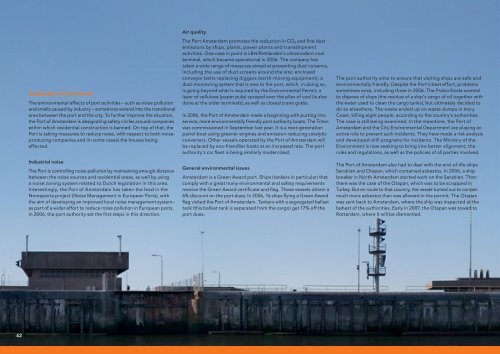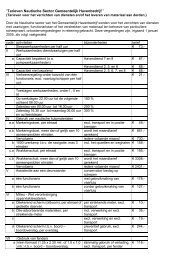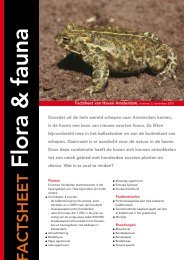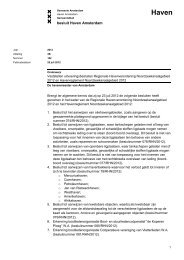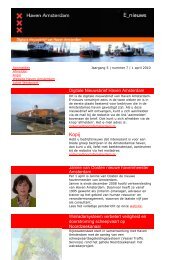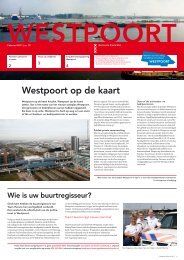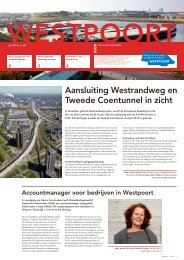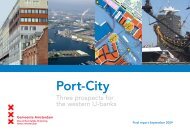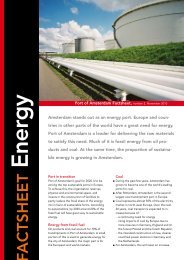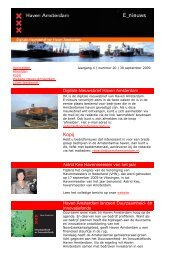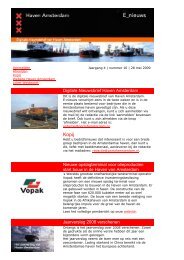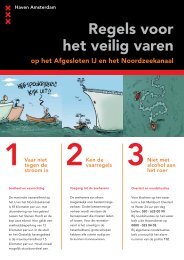Create successful ePaper yourself
Turn your PDF publications into a flip-book with our unique Google optimized e-Paper software.
2<br />
Sustainable environment<br />
The environmental effects of port activities – such as noise pollution<br />
and smells caused by industry – sometimes extend into the transitional<br />
area between the port and the city. To further improve the situation,<br />
the Port of Amsterdam is designating safety circles around companies<br />
within which residential construction is banned. On top of that, the<br />
Port is taking measures to reduce noise, with respect to both noiseproducing<br />
companies and (in some cases) the houses being<br />
affected.<br />
Industrial noise<br />
The Port is controlling noise pollution by maintaining enough distance<br />
between the noise sources and residential areas, as well by using<br />
a noise zoning system related to Dutch legislation in this area.<br />
Interestingly, the Port of Amsterdam has taken the lead in the<br />
Nomeports project (Noise Management in European Ports), with<br />
the aim of developing an improved local noise management system–<br />
as part of a wider effort to reduce noise pollution in European ports.<br />
In <strong>2006</strong>, the port authority set the first steps in this direction.<br />
Air quality<br />
The Port Amsterdam promotes the reduction in CO2 and fine dust<br />
emissions by ships, plants, power plants and transshipment<br />
activities. One case in point is LBH/Rietlanden’s ultramodern coal<br />
terminal, which became operational in <strong>2006</strong>. The company has<br />
taken a wide range of measures aimed at preventing dust nuisance,<br />
including the use of dust screens around the site; enclosed<br />
conveyor belts replacing diggers (earth-moving equipment); a<br />
dust-monitoring system that is new to the port, which, in doing so,<br />
is going beyond what is required by the Environmental Permit; a<br />
layer of cellulose (paper pulp) sprayed over the piles of coal (is also<br />
done at the older terminals); as well as closed crane grabs.<br />
In <strong>2006</strong>, the Port of Amsterdam made a beginning with putting into<br />
service, more environmentally friendly port authority boats. The Triton<br />
was commissioned in September last year. It is a next-generation<br />
patrol boat using greener engines and emission-reducing catalytic<br />
converters. Other vessels operated by the Port of Amsterdam will<br />
be replaced by eco-friendlier boats at an increased rate. The port<br />
authority’s car fleet is being similarly modernized.<br />
General environmental issues<br />
Amsterdam is a Green Award port. Ships (tankers in particular) that<br />
comply with a great many environmental and safety requirements<br />
receive the Green Award certificate and flag. These vessels obtain a<br />
6% discount on the port dues. In <strong>2006</strong>, 16 ships flying a Green Award<br />
flag visited the Port of Amsterdam. Tankers with a segregated ballast<br />
tank (this ballast tank is separated from the cargo) get 17% off the<br />
port dues.<br />
The port authority aims to ensure that visiting ships are safe and<br />
environmentally friendly. Despite the Port’s best effort, problems<br />
sometimes arise, including three in <strong>2006</strong>. The Probo Koala wanted<br />
to dispose of slops (the residue of a ship’s cargo of oil together with<br />
the water used to clean the cargo tanks), but ultimately decided to<br />
do so elsewhere. The waste ended up on waste dumps in Ivory<br />
Coast, killing eight people, according to the country’s authorities.<br />
The case is still being examined. In the meantime, the Port of<br />
Amsterdam and the City Environmental Department are playing an<br />
active role to prevent such incidents. They have made a risk analysis<br />
and developed drill programs for incidents. The Ministry of the<br />
Environment is now seeking to bring into better alignment, the<br />
rules and regulations, as well as the policies of all parties involved.<br />
The Port of Amsterdam also had to deal with the end-of-life ships<br />
Sandrien and Otapan, which contained asbestos. In <strong>2006</strong>, a ship<br />
breaker in North Amsterdam started work on the Sandrien. Then<br />
there was the case of the Otapan, which was to be scrapped in<br />
Turkey. But en route to that country, the vessel turned out to contain<br />
much more asbestos than was allowed in the permit. The Otapan<br />
was sent back to Amsterdam, where the ship was inspected at the<br />
behest of the authorities. Early in 2007, the Otapan was towed to<br />
Rotterdam, where it will be dismantled.


